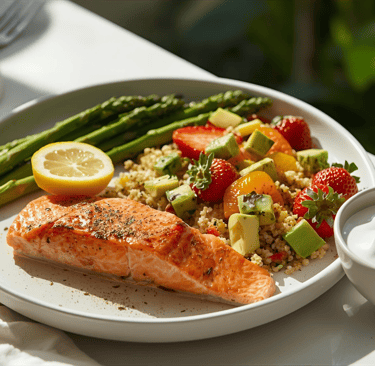Eat With the Seasons: A Natural Approach to Reducing Inflammation
Chronic inflammation plays a central role in many modern health issues—from joint pain and heart disease to autoimmune conditions and fatigue. But what if one of the simplest ways to combat inflammation is also one of the most natural? Eating seasonally is a powerful, sustainable way to nourish your body, support your immune system, and gently reduce inflammation—all while reconnecting with nature’s rhythms.
6/10/20252 min read


Chronic inflammation plays a central role in many modern health issues—from joint pain and heart disease to autoimmune conditions and fatigue. But what if one of the simplest ways to combat inflammation is also one of the most natural? Eating seasonally is a powerful, sustainable way to nourish your body, support your immune system, and gently reduce inflammation—all while reconnecting with nature’s rhythms.
🌱 Why Seasonal Eating Matters
Seasonal eating means choosing foods that are naturally harvested in your region at specific times of year. These foods are fresher, more nutrient-dense, and often require fewer resources to grow and transport. Making them better for you, and for the planet.
Most importantly, eating with the seasons offers natural variation. It brings diversity to your plate across the year, which is crucial when it comes to reducing chronic inflammation.
🌍 The Problem with Modern Food Systems
Currently, global agriculture relies heavily on just 12 plant species and 5 animal species for the majority of our calories, a number which was traditionally in the thousands. This lack of biodiversity not only weakens ecological resilience but also limits the diversity of nutrients and phytochemicals available in our diets, key players in managing inflammation and supporting long-term health.
Monocultures, over-processed foods, and year-round availability of the same produce contribute to a disconnect from natural cycles and an over-reliance on inflammatory, ultra-processed foods.
🍁 How Seasonal Foods Reduce Inflammation
Fresh, in-season produce tends to be richer in antioxidants, polyphenols and immune-supporting nutrients. For example:
Winter: Root vegetables, citrus fruits, brassicas (like kale and broccoli) - rich in vitamin C and fibre
Spring: Leafy greens and herbs - known for detoxifying compounds and chlorophyll
Summer: Berries, green beans, cucumbers - packed with hydration and antioxidant flavonoids
Autumn: Pumpkins, apples, beetroot - great for gut health and blood sugar balance
These natural shifts support your body's changing needs throughout the year, cooling and hydrating in summer, warming and grounding in winter.
🥘 Key Anti-Inflammatory Components (Found in Seasonal Foods)
Omega-3s – found in seasonal fish (like kahawai or trevally), walnuts and flaxseed
Polyphenols – from herbs, berries, green tea and apples
Fiber – from legumes, oats, root vegetables and leafy greens
Spices – turmeric, ginger, garlic and rosemary offer powerful inflammation-modulating effects
🛑 What to Minimise
Ultra-processed and packaged foods
Sugar-laden snacks and drinks
Industrial seed oils (like soybean or corn oil)
Over-reliance on imported, out-of-season produce
These not only strain your body but also disconnect you from local food rhythms.
🧭 Tips for Getting Started
Visit local farmers’ markets to see what’s in season near you
Grow a small herb or veggie garden to connect with seasonal rhythms
Plan your weekly meals around what’s freshest and most abundant
Freeze or preserve seasonal produce for future use—this adds convenience and variety later in the year
🌸 Sample Anti-Inflammatory Spring Meal
Spring Plate
Grilled salmon or chickpea patties with fresh herbs and lemon
Steamed asparagus and broad beans drizzled with extra virgin olive oil
Quinoa salad with baby spinach, avocado and citrus segments
A light dessert of strawberries and kiwifruit topped with unsweetened coconut yoghurt and a sprinkle of chia seeds
🌿 Food as Connection and Prevention
Seasonal eating isn't just about nutrition - it’s about connection: to your body, to your community, and to the land. It invites you to tune in, slow down, and support long-term health naturally.
By embracing more diversity through the seasons, we also push back against a food system that limits variety and increase our resilience, both biologically and ecologically.
🌎 Local Resources
In Aotearoa New Zealand, organisations like Sustainable Table, KaiCycle, and your local community garden can be great starting points for eating with the land.
Final Thought:
Food is more than fuel—it’s a message to your body. Eating seasonally, with a focus on anti-inflammatory choices, helps deliver the message of balance, vitality, and healing.
Phone/WhatsApp
+64 21 020 29366
Contact
Hours
Tuesday to Saturday 9am to 6pm
Please get in touch to enquire about alternative timing
Professional Affiliations
Legal Information
At Wellness Your Way Ltd, we value transparency and integrity in all that we do. Our legal policies outline how we protect your privacy, manage your information and deliver services with care and professionalism.
Terms and Conditions: Explains how our services operate, including payments, cancellations, digital resources and client agreements.
Privacy Policy: Details how we collect, store and protect your personal information in accordance with New Zealand privacy standards.
Disclaimer: Clarifies that our wellness, nutrition and NLP coaching services are for educational and lifestyle purposes only and are not a substitute for medical care.
© 2025 Wellness Your Way Ltd. Wellness Your Way® and the Wellness Your Way logo are registered trademarks of Wellness Your Way Ltd. All rights reserved.






